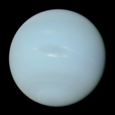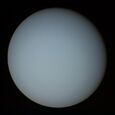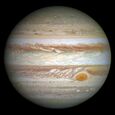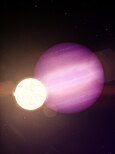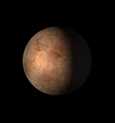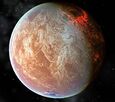Astronomy:List of coolest exoplanets
From HandWiki
Short description: none
This is a list of the coolest exoplanets known, specifically those with temperatures lower than −75 °C (198 K). Planets from the Solar System were also included for comparison purposes.
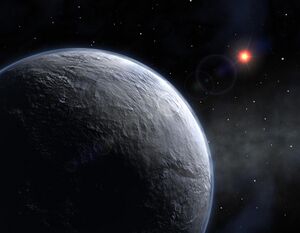
Discovered in 2006, OGLE-2005-BLG-390Lb is the coldest known exoplanet, and was nicknamed "Hoth" by NASA in reference to the planet from the Star Wars franchise.[1]
List
| Image
(Or artistic representation) |
Name | Temperature | Mass
(M⊕ or MJ) |
Method[lower-alpha 1] | Notes | References |
|---|---|---|---|---|---|---|
| OGLE-2005-BLG-390Lb | -223 °C (50 K) | 000550 5.5 M⊕
|
Teq | The coldest known exoplanet, with a temperature lower than the melting points of oxygen and nitrogen. [lower-alpha 2] | [4] | |
| OGLE-2005-BLG-071L b | -218 °C | 120764 3.8 Jupiter mass
|
[5] | |||
| PSR B1620-26 b | -201.2 °C | 079450 2.5 Jupiter mass
|
One of the oldest exoplanets known, with an age of 12.7 billion years.[note 1] | [6] | ||
| Neptune (For reference) | -200 °C | 001715 17.15 M⊕
|
[7][8] | |||
| Uranus (For reference) | -195 °C | 001454 14.54 M⊕
|
[7][9] | |||
| TOI-969 c | -176.6+6.8 −5.8 °C |
Teq | [10] | |||
| HIP 11915 b | -155 °C | 031462 0.99 Jupiter mass
|
A Jupiter analog. | [lower-alpha 3] | ||
| GJ 414 A c | -148.3±13.5 °C | 005383 53.83 M⊕
|
[11] | |||
| HD 191939 f | < -148 °C | 066738 2.1 Jupiter mass
|
[12] | |||
| Saturn (For reference) | -140 °C | 009500 95 M⊕
|
[7][13] | |||
| Kepler-167 e | -138.6±5 °C | 032097 1.01 Jupiter mass
|
Teq | [14] | ||
| HD 115954 b | -128.1+8.1 −13 °C |
263456 8.29 Jupiter mass
|
[15] | |||
| Gliese 777 b | -123+26 −27 °C |
057204 1.8 Jupiter mass
|
[16] | |||
| Epsilon Eridani b (AEgir) | -123 °C | 020000 0.63 Jupiter mass
|
[17][18] | |||
| HD 164922 b | -114 °C | 011600 0.365 Jupiter mass
|
[19][20] | |||
| Jupiter (For reference) | -110 °C | 031780 317.8 M⊕
(1 Jupiter mass)
|
[7][21] | |||
| WD 1856+534 b | -110+14 −18 °C |
438564 <13.8 Jupiter mass
|
Teq | [22] | ||
| PSR B1257+12 d (Phobetor) | -104 °C | 000390 3.9 M⊕
|
One of the first exoplanets discovered. | [23] | ||
| HR 5183 b | -102+5.2 −5.1 °C |
102649 3.23 Jupiter mass
|
A highly-eccentric orbit planet. | [24] | ||
| TRAPPIST-1h | -101.5 °C | 000033 0.326 M⊕
|
[25] | |||
| TOI-4010 e | -99+8 −6 °C |
069208 2.18 Jupiter mass
|
[26] | |||
| HATS-59 c | -97.1±6.4 °C | 403606 12.7 Jupiter mass
|
[27] | |||
| HD 86226 b | -97±4 °C | 014301 0.45 Jupiter mass
|
[28] | |||
| Gliese 1002 c | -91.3±5.2 °C[lower-alpha 4] | 000136 1.36 M⊕
|
Orbits within its star's habitable zone. | [29] | ||
| EPIC 248847494 b | -90+25 −18 °C |
413140 <13 Jupiter mass
|
[30] | |||
| Kepler-421b | -88.2+8.6 −4.8 °C |
The transiting exoplanet with the longest orbital period. (704 days)[31] | [32] | |||
| HD 192310 c | -88 °C | 002400 24 M⊕
|
[33] | |||
| Kepler-16b | -85 °C | 010582 0.333 Jupiter mass
|
A circumbinary planet. | [34] | ||
| Kepler-186f | -85 °C[lower-alpha 5] | 000144 1.44 M⊕
|
Potentially habitable | [35][36] | ||
| TOI-4600 c | -82±6 °C | 294600 <9.27 Jupiter mass
|
[37] | |||
| PSR B1257+12 c (Poltergeist) | -80 °C | 000430 4.3 M⊕
|
One of the first exoplanets discovered. | [38] | ||
| Gliese 876 b | -79 °C | 083564 2.66 Jupiter mass
|
[39][40] | |||
| TRAPPIST-1g | -75.8 °C | 000132 1.321 M⊕
|
Potentially habitable | [25][35][41] |
Unconfirmed candidates
These exoplanets have not been confirmed.
| Image
(Or artistic representation) |
Name | Temperature | Mass[lower-alpha 6] | Method[lower-alpha 1] | Notes | References |
|---|---|---|---|---|---|---|
| Proxima Centauri c | -234.2 °C (38.8 K) | 7 M⊕ | Teq | [42][43] |
Notes and references
- ↑ "Meet 8 'Star Wars' Planets in Our Own Galaxy". May 1, 2023. https://exoplanets.nasa.gov/news/239/meet-8-star-wars-planets-in-our-own-galaxy/.
- ↑ "Nitrogen - Melting Point - Boiling Point | nuclear-power.com" (in en-us). 2021-11-26. https://www.nuclear-power.com/nitrogen-melting-point-boiling-point/.
- ↑ "Error: no
|title=specified when using {{Cite web}}". http://www.chem.uiuc.edu/rogers/Text9/Tx91/tx91.html#:~:text=The%20normal%20melting%20point%20of,a%20gas%20at%20room%20temperature.. - ↑ Beaulieu, J. -P.; Bennett, D. P.; Fouqué, P.; Williams, A.; Dominik, M.; Jørgensen, U. G.; Kubas, D.; Cassan, A. et al. (2006-01-01). "Discovery of a cool planet of 5.5 Earth masses through gravitational microlensing". Nature 439 (7075): 437–440. doi:10.1038/nature04441. ISSN 0028-0836. PMID 16437108. Bibcode: 2006Natur.439..437B. https://ui.adsabs.harvard.edu/abs/2006Natur.439..437B.
- ↑ Dong, Subo; Gould, Andrew; Udalski, Andrzej; Anderson, Jay; Christie, G. W.; Gaudi, B. S.; OGLE Collaboration; Jaroszyński, M. et al. (2009-04-01). "OGLE-2005-BLG-071Lb, the Most Massive M Dwarf Planetary Companion?". The Astrophysical Journal 695 (2): 970–987. doi:10.1088/0004-637X/695/2/970. ISSN 0004-637X. Bibcode: 2009ApJ...695..970D. https://ui.adsabs.harvard.edu/abs/2009ApJ...695..970D.
- ↑ "PSR B1620-26b (Cold jovian)". https://www.hpcf.upr.edu/~abel/phl/hec_plots/hec_orbit/hec_orbit_PSR_B1620-26_b.png.
- ↑ 7.0 7.1 7.2 7.3 "Solar System Temperatures - NASA Science" (in en). https://science.nasa.gov/resource/solar-system-temperatures/.
- ↑ "Neptune Fact Sheet". https://nssdc.gsfc.nasa.gov/planetary/factsheet/neptunefact.html.
- ↑ "Uranus Fact Sheet". https://nssdc.gsfc.nasa.gov/planetary/factsheet/uranusfact.html.
- ↑ "Planetary Systems". https://exoplanetarchive.ipac.caltech.edu/cgi-bin/TblView/nph-tblView?app=ExoTbls&config=PS.
- ↑ Dedrick, Cayla M.; Fulton, Benjamin J.; Knutson, Heather A.; Howard, Andrew W.; Beatty, Thomas G.; Cargile, Phillip A.; Gaudi, B. Scott; Hirsch, Lea A. et al. (2021-02-01). "Two Planets Straddling the Habitable Zone of the Nearby K Dwarf Gl 414A". The Astronomical Journal 161 (2): 86. doi:10.3847/1538-3881/abd0ef. ISSN 0004-6256. Bibcode: 2021AJ....161...86D.
- ↑ Orell-Miquel, J.; Nowak, G.; Murgas, F.; Palle, E.; Morello, G.; Luque, R.; Badenas-Agusti, M.; Ribas, I. et al. (2023-01-01). "HD 191939 revisited: New and refined planet mass determinations, and a new planet in the habitable zone". Astronomy and Astrophysics 669: A40. doi:10.1051/0004-6361/202244120. ISSN 0004-6361. Bibcode: 2023A&A...669A..40O. https://ui.adsabs.harvard.edu/abs/2023A&A...669A..40O.
- ↑ "Saturn Fact Sheet". https://nssdc.gsfc.nasa.gov/planetary/factsheet/saturnfact.html.
- ↑ Chachan, Yayaati; Dalba, Paul A.; Knutson, Heather A.; Fulton, Benjamin J.; Thorngren, Daniel; Beichman, Charles; Ciardi, David R.; Howard, Andrew W. et al. (2022-02-01). "Kepler-167e as a Probe of the Formation Histories of Cold Giants with Inner Super-Earths". The Astrophysical Journal 926 (1): 62. doi:10.3847/1538-4357/ac3ed6. ISSN 0004-637X. Bibcode: 2022ApJ...926...62C.
- ↑ Demangeon, O. D. S.; Dalal, S.; Hébrard, G.; Nsamba, B.; Kiefer, F.; Camacho, J. D.; Sahlmann, J.; Arnold, L. et al. (2021-09-01). "The SOPHIE search for northern extrasolar planets. XVIII. Six new cold Jupiters, including one of the most eccentric exoplanet orbits". Astronomy and Astrophysics 653: A78. doi:10.1051/0004-6361/202141079. ISSN 0004-6361. Bibcode: 2021A&A...653A..78D. https://ui.adsabs.harvard.edu/abs/2021A&A...653A..78D.
- ↑ Feng, Fabo; Butler, R. Paul; Jones, Hugh R. A.; Phillips, Mark W.; Vogt, Steven S.; Oppenheimer, Rebecca; Holden, Bradford; Burt, Jennifer et al. (2021-10-01). "Optimized modelling of Gaia-Hipparcos astrometry for the detection of the smallest cold Jupiter and confirmation of seven low-mass companions". Monthly Notices of the Royal Astronomical Society 507 (2): 2856–2868. doi:10.1093/mnras/stab2225. ISSN 0035-8711. Bibcode: 2021MNRAS.507.2856F. https://ui.adsabs.harvard.edu/abs/2021MNRAS.507.2856F.
- ↑ Mawet, Dimitri; Hirsch, Lea; Lee, Eve J.; Ruffio, Jean-Baptiste; Bottom, Michael; Fulton, Benjamin J.; Absil, Olivier; Beichman, Charles et al. (2019-01-03). "Deep exploration of $\epsilon$ Eridani with Keck Ms-band vortex coronagraphy and radial velocities: mass and orbital parameters of the giant exoplanet". The Astronomical Journal 157 (1): 33. doi:10.3847/1538-3881/aaef8a. ISSN 1538-3881.
- ↑ Fritz Benedict, G. (2022-03-09). "Revisiting HST/FGS Astrometry of ϵ Eridani*". Research Notes of the AAS 6 (3): 45. doi:10.3847/2515-5172/ac5b6b. ISSN 2515-5172. Bibcode: 2022RNAAS...6...45B.
- ↑ Benatti, S.; Damasso, M.; Desidera, S.; Marzari, F.; Biazzo, K.; Claudi, R.; Di Mauro, M. P.; Lanza, A. F. et al. (2020-07-01). "The GAPS programme at TNG. XXIII. HD 164922 d: close-in super-Earth discovered with HARPS-N in a system with a long-period Saturn mass companion". Astronomy and Astrophysics 639: A50. doi:10.1051/0004-6361/202037939. ISSN 0004-6361. Bibcode: 2020A&A...639A..50B. https://ui.adsabs.harvard.edu/abs/2020A&A...639A..50B.
- ↑ Fulton, Benjamin J.; Howard, Andrew W.; Weiss, Lauren M.; Sinukoff, Evan; Petigura, Erik A.; Isaacson, Howard; Hirsch, Lea; Marcy, Geoffrey W. et al. (2016-10-10). "Three Temperate Neptunes Orbiting Nearby Stars". The Astrophysical Journal 830 (1): 46. doi:10.3847/0004-637x/830/1/46. ISSN 1538-4357. Bibcode: 2016ApJ...830...46F.
- ↑ "Jupiter Fact Sheet". https://nssdc.gsfc.nasa.gov/planetary/factsheet/jupiterfact.html.
- ↑ Vanderburg, Andrew; Rappaport, Saul A.; Xu, Siyi; Crossfield, Ian J. M.; Becker, Juliette C.; Gary, Bruce; Murgas, Felipe; Blouin, Simon et al. (2020-09-01). "A giant planet candidate transiting a white dwarf". Nature 585 (7825): 363–367. doi:10.1038/s41586-020-2713-y. ISSN 0028-0836. PMID 32939071. Bibcode: 2020Natur.585..363V. https://ui.adsabs.harvard.edu/abs/2020Natur.585..363V.
- ↑ Extrasolar Visions - PSR 1257+12 C
- ↑ Blunt, Sarah; Endl, Michael; Weiss, Lauren M.; Cochran, William D.; Howard, Andrew W.; MacQueen, Phillip J.; Fulton, Benjamin J.; Henry, Gregory W. et al. (2019-11-01). "Radial Velocity Discovery of an Eccentric Jovian World Orbiting at 18 au". The Astronomical Journal 158 (5): 181. doi:10.3847/1538-3881/ab3e63. ISSN 0004-6256. Bibcode: 2019AJ....158..181B.
- ↑ 25.0 25.1 Ducrot, Elsa; Gillon, M.; Delrez, L.; Agol, E.; Rimmer, P.; Turbet, M.; Günther, M. N.; Demory, B.-O. et al. (August 2020). "TRAPPIST-1: Global Results of the Spitzer Exploration Science Program {\it Red Worlds}". Astronomy & Astrophysics 640: A112. doi:10.1051/0004-6361/201937392. ISSN 0004-6361.
- ↑ Kunimoto, Michelle; Vanderburg, Andrew; Huang, Chelsea X.; Davis, M. Ryleigh; Affer, Laura; Cameron, Andrew Collier; Charbonneau, David; Cosentino, Rosario et al. (2023-07-01). "TOI-4010: A System of Three Large Short-period Planets with a Massive Long-period Companion". The Astronomical Journal 166 (1): 7. doi:10.3847/1538-3881/acd537. ISSN 0004-6256. Bibcode: 2023AJ....166....7K.
- ↑ Sarkis, P.; Henning, Th.; Hartman, J. D.; Bakos, G. Á.; Brahm, R.; Jordán, A.; Bayliss, D.; Mancini, L. et al. (2018-11-01). "HATS-59b,c: A Transiting Hot Jupiter and a Cold Massive Giant Planet around a Sun-like Star". The Astronomical Journal 156 (5): 216. doi:10.3847/1538-3881/aade54. ISSN 0004-6256. Bibcode: 2018AJ....156..216S.
- ↑ Teske, Johanna; Díaz, Matías R.; Luque, Rafael; Močnik, Teo; Seidel, Julia V.; Otegi, Jon Fernández; Feng, Fabo; Jenkins, James S. et al. (2020-08-01). "TESS Reveals a Short-period Sub-Neptune Sibling (HD 86226c) to a Known Long-period Giant Planet". The Astronomical Journal 160 (2): 96. doi:10.3847/1538-3881/ab9f95. ISSN 0004-6256. Bibcode: 2020AJ....160...96T.
- ↑ Suárez Mascareño, A.; González-Álvarez, E.; Zapatero Osorio, M. R.; Lillo-Box, J.; Faria, J. P.; Passegger, V. M.; González Hernández, J. I.; Figueira, P. et al. (2023-02-01). "Two temperate Earth-mass planets orbiting the nearby star GJ 1002". Astronomy and Astrophysics 670: A5. doi:10.1051/0004-6361/202244991. ISSN 0004-6361. Bibcode: 2023A&A...670A...5S. https://ui.adsabs.harvard.edu/abs/2023A&A...670A...5S.
- ↑ Giles, H. A. C.; Osborn, H. P.; Blanco-Cuaresma, S.; Lovis, C.; Bayliss, D.; Eggenberger, P.; Collier Cameron, A.; Kristiansen, M. H. et al. (2018-07-01). "Transiting planet candidate from K2 with the longest period". Astronomy and Astrophysics 615: L13. doi:10.1051/0004-6361/201833569. ISSN 0004-6361. Bibcode: 2018A&A...615L..13G. https://ui.adsabs.harvard.edu/abs/2018A&A...615L..13G.
- ↑ "Transiting Exoplanet with Longest Known Year". https://exoplanets.nasa.gov/resources/179/transiting-exoplanet-with-longest-known-year/.
- ↑ Kipping, D. M.; Torres, G.; Buchhave, L. A.; Kenyon, S. J.; Henze, C.; Isaacson, H.; Kolbl, R.; Marcy, G. W. et al. (2014-11-01). "Discovery of a Transiting Planet near the Snow-line". The Astrophysical Journal 795 (1): 25. doi:10.1088/0004-637X/795/1/25. ISSN 0004-637X. Bibcode: 2014ApJ...795...25K. https://ui.adsabs.harvard.edu/abs/2014ApJ...795...25K.
- ↑ Pepe, F.; Lovis, C.; Ségransan, D.; Benz, W.; Bouchy, F.; Dumusque, X.; Mayor, M.; Queloz, D. et al. (2011-10-01). "The HARPS search for Earth-like planets in the habitable zone. I. Very low-mass planets around HD 20794, HD 85512, and HD 192310". Astronomy and Astrophysics 534: A58. doi:10.1051/0004-6361/201117055. ISSN 0004-6361. Bibcode: 2011A&A...534A..58P.
- ↑ Doyle, Laurance R.; Carter, Joshua A.; Fabrycky, Daniel C.; Slawson, Robert W.; Howell, Steve B.; Winn, Joshua N.; Orosz, Jerome A.; Prsa, Andrej et al. (2011-09-16). "Kepler-16: A Transiting Circumbinary Planet". Science 333 (6049): 1602–1606. doi:10.1126/science.1210923. ISSN 0036-8075. PMID 21921192. Bibcode: 2011Sci...333.1602D.
- ↑ 35.0 35.1 "PHL @ UPR Arecibo - The Habitable Exoplanets Catalog" (in en-US). https://phl.upr.edu/projects/habitable-exoplanets-catalog.
- ↑ Quintana, Elisa V.; Barclay, Thomas; Raymond, Sean N.; Rowe, Jason F.; Bolmont, Emeline; Caldwell, Douglas A.; Howell, Steve B.; Kane, Stephen R. et al. (2014-04-18). "An Earth-sized Planet in the Habitable Zone of a Cool Star". Science 344 (6181): 277–280. doi:10.1126/science.1249403. ISSN 0036-8075. PMID 24744370. Bibcode: 2014Sci...344..277Q.
- ↑ Mireles, Ismael; Dragomir, Diana; Osborn, Hugh P.; Hesse, Katharine; Collins, Karen A.; Villanueva, Steven; Bieryla, Allyson; Ciardi, David R. et al. (2023-09-01). "TOI-4600 b and c: Two Long-period Giant Planets Orbiting an Early K Dwarf". The Astrophysical Journal 954 (1): L15. doi:10.3847/2041-8213/aceb69. ISSN 0004-637X. Bibcode: 2023ApJ...954L..15M.
- ↑ Extrasolar Visions - PSR 1257+12 B
- ↑ "Archived copy". http://www.hpcf.upr.edu/~abel/phl/hec_plots/hec_orbit/hec_orbit_Gliese_876_b.png.
- ↑ Millholland, Sarah; Laughlin, Gregory; Teske, Johanna; Butler, R. Paul; Burt, Jennifer; Holden, Bradford; Vogt, Steven; Crane, Jeffrey et al. (2018-02-08). "New Constraints on Gliese 876 -- Exemplar of Mean-Motion Resonance". The Astronomical Journal 155 (3): 106. doi:10.3847/1538-3881/aaa894. ISSN 1538-3881. Bibcode: 2018AJ....155..106M.
- ↑ Agol, Eric; Dorn, Caroline; Grimm, Simon L.; Turbet, Martin; Ducrot, Elsa; Delrez, Laetitia; Gillon, Michaël; Demory, Brice-Olivier et al. (2021-01-22). "Refining the Transit-timing and Photometric Analysis of TRAPPIST-1: Masses, Radii, Densities, Dynamics, and Ephemerides" (in en). The Planetary Science Journal 2 (1): 1. doi:10.3847/PSJ/abd022. ISSN 2632-3338. Bibcode: 2021PSJ.....2....1A.
- ↑ Benedict, G. Fritz; McArthur, Barbara E. (June 2020). "A Moving Target—Revising the Mass of Proxima Centauri c*" (in en). Research Notes of the AAS 4 (6): 86. doi:10.3847/2515-5172/ab9ca9. ISSN 2515-5172. Bibcode: 2020RNAAS...4...86B.
- ↑ Damasso, Mario; Del Sordo, Fabio; Anglada-Escudé, Guillem; Giacobbe, Paolo; Sozzetti, Alessandro; Morbidelli, Alessandro; Pojmanski, Grzegorz; Barbato, Domenico et al. (2020-01-01). "A low-mass planet candidate orbiting Proxima Centauri at a distance of 1.5 AU". Science Advances 6 (3): eaax7467. doi:10.1126/sciadv.aax7467. PMID 31998838. Bibcode: 2020SciA....6.7467D.
- ↑ 1.0 1.1 Teff: Measured effective temperature. Teq: The temperature of the planet has not been measured, so it is listed with the calculated equilibrium temperature.
- ↑ The melting points of Nitrogen and Oxygen are -210°C and -218°C, respectively.[2][3]
- ↑ This was obtained using the CalcTool luminosity converter. Using the apparent magnitude of HIP 11915 and its distance from Earth (using the uncertainty parameter of ±10 light years), this yields a range of 1.03–1.27 L☉. When used in the default 190 light-year distance (with margin of error) is 1.07+0.11
−0.09 L☉. When run into simulations using the orbital distance of HIP 11915 and its planet, yields a result of 118 K. - ↑ This is the surface temperature if Gliese 1002 c has no atmosphere.
- ↑ This is the surface temperature if Kepler-186f has no atmosphere.
- ↑ M⊕: Earth mass MJ: Jupiter mass
 |


